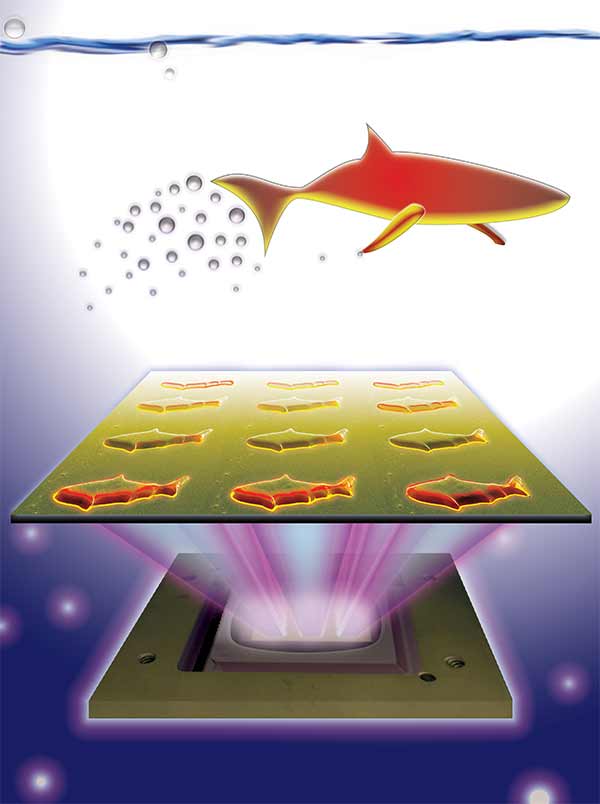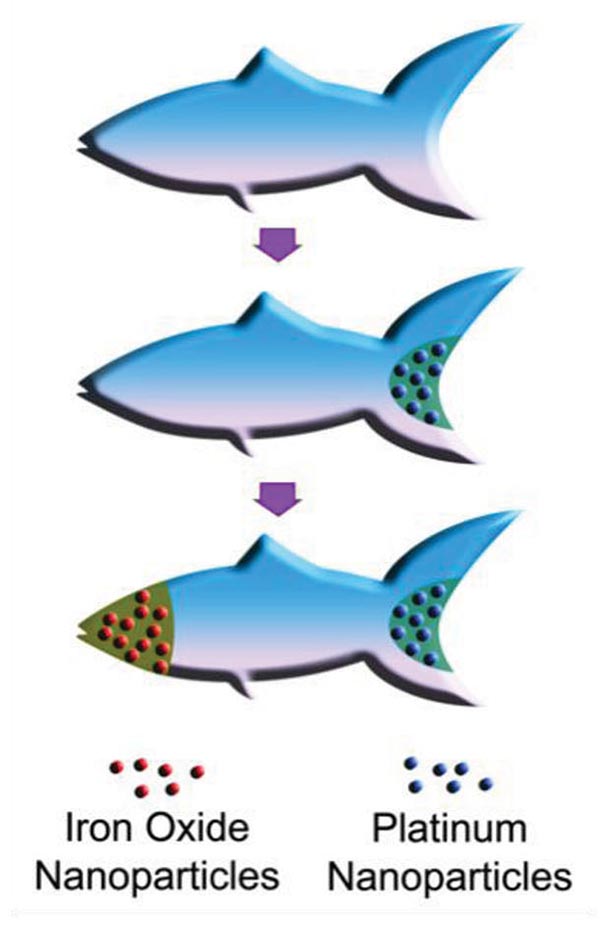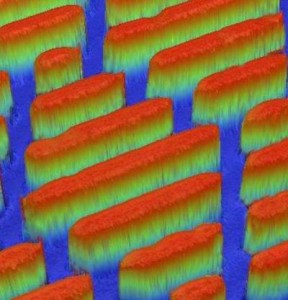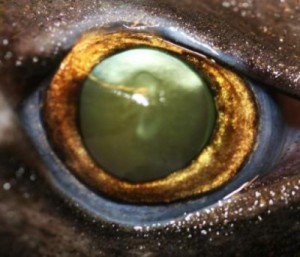A virgin birth story seems particularly apt at this time of the year (as I was taught the story, Jesus was born of a virgin birth on Christmas Day). As for the whistled language story, that’s pure self-indulgence.
Virgin shark birth
From an August 26, 2021 article by Harry Baker for Live Science (Note: Links have been removed),
A shark’s rare “virgin birth” in an Italian aquarium may be the first of its kind, scientists say.
The female baby smoothhound shark (Mustelus mustelus) — known as Ispera, or “hope” in *Sardinian* — was recently born at the Cala Gonone Aquarium in Sardinia to a mother that has spent the past decade sharing a tank with one other female and no males, Newsweek reported.
This rare phenomenon, known as parthenogenesis, is the result of females’ ability to self-fertilize their own eggs in extreme scenarios. Parthenogenesis has been observed in more than 80 vertebrate species — including sharks, fish and reptiles — but this may be the first documented occurrence in a smoothhound shark, according to Newsweek.
“It has been documented in quite a few species of sharks and rays now,” Demian Chapman, director of the sharks and rays conservation program at Mote Marine Laboratory & Aquarium in Florida, told Live Science. “But it is difficult to detect in the wild, so we really only know about it from captive animals,” said Chapman, who has led several studies on shark parthenogenesis.
A September 2, 2021 article by Louisa Wright for DW.com provides additional details (Note: Links have been removed),
To procreate, most species require an egg to be fertilized by a sperm. That’s the case with sharks, too. But some animals can produce offspring all by themselves. This is called parthenogenesis.
The term comes from the Greek words parthenos, meaning “virgin,” and genesis, meaning “origin.”
The case in Italy could be the first time this “immaculate conception” has occurred in smooth-hound sharks, at least in captivity.
…
… scientists still don’t know how often it happens, says Kevin Feldheim, a researcher at the Field Museum in Chicago, who researches the mating habits of sharks.”We don’t know how common it is and the handful of cases we have seen have mostly taken place in an aquarium setting,” Feldheim told DW.
One study from the Field Museum discovered parthenogenesis in a wild population of smalltooth sawfish, a type of ray. This was the first time a vertebrate (animals with backbones inside their body), which usually reproduces the conventional way with a mate, was found to reproduce asexually in the wild, Feldheim said.
…
Whistling could give insight into dolphin communication
A September 21, 2021 news item on phys.org announces research into how whistled languages might help us understand dolphins better,
Whistling while you work isn’t just a distraction for some people. More than 80 cultures employ a whistled form of their native language to communicate over long distances. A multidisciplinary team of scientists believe that some of these whistled languages can serve as a model for elucidating how information may be encoded in dolphin whistle communication. They made their case in a new paper published in the journal Frontiers in Psychology.
…
A September 21, 2021 Frontiers [open access publishers] news release on EurekAlert explains how whistled languages might provide a key to understanding dolphin communication,
Whistled human speech mostly evolved in places where people live in rugged terrain, such as mountains or dense forest, because the sounds carry much farther than ordinary speech or even shouting. While these whistled languages vary by region and culture, the basic principle is the same: People simplify words, syllable by syllable, into whistled melodies.
Trained whistlers can understand an amazing amount of information. In whistled Turkish, for example, common whistled sentences are understood up to 90 percent of the time. This ability to extract meaning from whistled speech has attracted linguists and other researchers interested in investigating the intricacies of how the human brain processes and even creates language.
The idea that human whistled speech could also be a model for how mammals like bottlenose dolphins communicate first emerged in the 1960s with work by René-Guy Busnel, a French researcher who pioneered the study of whistled languages. More recently, some of Busnel’s former colleagues have teamed up to explore the potential synergy between bottlenose dolphins and humans, which have largest brain relative to body size on the planet.
While humans and dolphins produce sounds and convey information differently, the structure and attributes found across human whistle languages may provide insights as to how bottlenose dolphins encode complex information, according to coauthor Dr Diana Reiss, a professor of psychology at Hunter College in the United States whose research focuses on understanding cognition and communication in dolphins and other cetaceans.
Lead author Dr Julien Meyer, a linguist in the Gipsa Lab at the French national research center (CNRS), offered this example: The ability of a listener to decode human language or whistled speech relies on the listener’s language competency, such as understanding phonemes, a unit of sound that can distinguish one word from another. However, images of sounds called sonograms are not always segmented by silences between these units in human whistled speech.
“By contrast, scientists trying to decode the whistled communication of dolphins and other whistling species often categorize whistles based on the silent intervals between whistles,” Reiss noted. In other words, researchers may need to rethink how they categorize whistled animal communication based on what the sonograms reveal about how information is conveyed structurally in human whistled speech.
Meyer, Reiss and coauthor Dr Marcelo Magnasco, a biophysicist and professor at Rockefeller University, plan to apply this and other insights discussed in their paper to develop new techniques to analyze dolphin whistles. They will leverage dolphin whistle data compiled by Reiss and Magnasco with a database on whistled speech that Meyer has been collecting since 2003 with the CNRS, the Collegium of Lyon, the Museu Paraense Emílio Goeldi in Brazil and several nonprofit research associations focused on whistled and instrumental speech (The World Whistles, Yo Silbo, Silbo herreño).
“On these data, for example, we will develop new algorithms and test some hypotheses about combinatorial structure,” Meyer said, referring to the building blocks of language like phonemes that can be combined to impart meaning.
Magnasco noted that scientists already use machine learning and AI to help track dolphins in videos and even to identify dolphin calls. However, Reiss said, to have an AI algorithm capable of “deciphering” dolphin whistle communication, “we would need to know what the minimum unit of meaningful sound is, how they are organized, and how they function.”
Here’s a link to and a citation for the paper,
The Relevance of Human Whistled Languages for the Analysis and Decoding of Dolphin Communication by Julien Meyer, Marcelo O. Magnasco, and Diana Reiss. Front. Psychol., 21 September 2021 DOI: https://doi.org/10.3389/fpsyg.2021.689501
This paper is open access.
*December 30, 2021: “The female baby smoothhound shark (Mustelus mustelus) — known as Ispera, or “hope” in Maltese …” was corrected to “hope” in Sardinian … .” When you think about it, it makes a lot more sense than naming a special baby shark in a language not native to where it was born. Thank you to Carla and her partner who is from Sardinia!*



